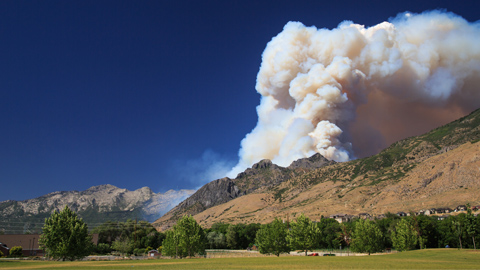As wards and stakes identify potential disasters in the area, the Disaster Review and Planning for Disruptions worksheets help them prioritize their planning efforts and identify short-term and long-term solutions.
Disaster Review
The Disaster Review worksheet helps wards and stakes identify potential disasters and disruptions in the area so they can prioritize emergency preparations. It also provides a template for beginning preparedness and response planning on the stake and ward levels.
On the left side of the Disaster Review worksheet is a column to list potential disasters. The other columns show necessities that could be potentially disrupted by a disaster, such as: physical safety, power sources, communication, shelter, and emotional and spiritual well-being.
Using the Disaster Review worksheet will help wards and stakes prepare for disruptions. For example, whether the disaster is a hurricane, ice storm, snowstorm or landslide, it will require preparing for a disruption to the power supply. Wards and stakes cannot prepare for every possible contingency, so prioritize planning efforts according to the most likely disruptions.
Planning for Disruptions
The Planning for Disruptions worksheet is used to identify a disruption and plan solutions based on the highest identified needs. These solutions may be immediate (the first 72 hours), mid-term (the first few weeks) or long-term (more than two months). This worksheet focuses on the disruption rather than the disaster, since the need and response may be the same across disasters. For example, a flashlight is a useful resource in a variety of disasters where power sources are affected, but it would be limited as a long-term resource.
To complete the Planning for Disruptions worksheet, choose the highest priority disruption determine immediate, mid-term, and long-term response capabilities.
Example: Damage to Homes
Short-term: In a disaster such as an earthquake, fire, flood, or hurricane, a key immediate response would be to provide or find temporary shelter for displaced families, such as in a meetinghouse or community shelter, until homes are cleaned up and habitable.
Mid-term: The ward may choose to purchase or gather supplies, such as tents or other structures, to help in temporarily housing displaced families.
Long-term: This plan may include building more permanent shelters or following up with insurance claims. It may also include helping members find housing until their own housing can be repaired or replaced. Housing options could come from:
- Family or friends.
- Ward or stake members.
- Community resources.
Complete the Planning for Disruptions worksheet for each possible disruption. As the council completes the worksheet, identify any gaps in the emergency plan. Use the Actions and Assignments worksheet to complete the plan.
Take Action:
1. Use the Disaster Review worksheet to identify potential disasters.
2. Using the results of the Disaster Review worksheet, prioritize potential disruptions to prepare for.
3. Starting with the highest-priority disruptions, use the Planning for Disruptions worksheet to create timelines for disaster response for each potential disruption.
4. Identify deficiencies in the current plan and use the Actions and Assignments worksheet to complete the plan.
